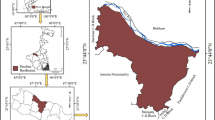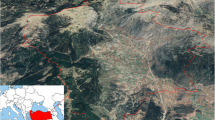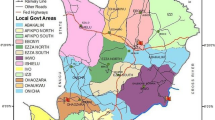Abstract
The study has been conducted to evaluate the impact of brickfields on soil quality of agricultural land around the brickfields within the study area of the Bhagirathi-Hugli river basin. It has been carried out by determining the chemical properties such as pH, electrical conductivity (EC), organic carbon (OC), nitrogen (N), phosphorus (P), and potassium (K) of soil. In this study, 18 samples have been collected from 6 brickfields of distance 100, 400 and 800 m respectively of depth 0–25 cm. The data show that pH and EC are decreased from increasing distances of the brickfields but the value of OC, N, P, and K are increased from increasing distances of the brick kilns. The result of ANOVA shows that EC has insignificant differences, but P within different distant zones. Tukey test informs that P is remarkably different between the distant groups of 100–800 m and 400–800 m but 100–400 m at the significant value of 0.05. Results of the Kruskal–Wallis test indicates that the soil pH and potassium (K) are significantly different, but OC and N are not. The Dwass–Steel–Critchlow–Fligner test also indicates that the different distant groups of pH (100–400 m and 400–800 m) and K (400–800 m) are of a trivial difference in the significant value of 0.05. The overall study reveals that the quality of the soil is deteriorating close to brickfield from far distances due to indiscriminate activities of brick kiln industry.








Similar content being viewed by others
References
Sharma, P. D. (2011–2012). Ecology and environment (11th, rev. edn). Meerut: Rastogi Publication. www.rastogipublications.com.
Husain, M. (2008). Systematic agricultural geography. Jaipur: Rawat Publications.
Biswas, D., Gurley, E. S., Rutherford, S., & Luby, S. P. (2018). The drivers and impacts of selling soil for brick making in Bangladesh. Environmental Management,62, 792–802. https://doi.org/10.1007/s00267-018-1072-z.
Kahl, H. (2004). Role and importance of nitrogen in your soil. Organic NZ Magazine. Retrieved Feb 7, 2019, from https://organicnz.org.nz/magazine-articles/role-importance-nitrogen-soil.
Patra, P., Guray, A., & Ganguly, S. (2015). A study on brick kiln industry in Pursura block of Hooghly District, West Bengal. International Journal of Applied Research,1(9), 95–99.
Chanda, D. (2016). A study on socio-demographic and health condition of brickfield workers in different areas of Bangladesh. Dhaka: East–West University.
Sarkar, M. A. W., Kabir, M. H., Lira, S. A., Razzaque, A., & Sarker, M. R. H. (2016). Comparison of soil nutrients status between an agricultural land close by brickfield and a productive agricultural land for agricultural activities in Sadar Upazilla, Sherpur. Bangladesh. Journal of Soil and Nature,9(1), 8–12.
Khan, H. R., Rahman, K., Abdur Rouf, A. J. M., Sattar, G. S., Oki, Y., & Adachi, T. (2007). Assessment of degradation of agricultural soils arising from brick burning in selected soil profiles. International Journal of Environmental Science and Technology,4(4), 471–480.
Nath, A. J., Lal, R., & Das, A. K. (2018). Fired bricks: CO2 emission and food insecurity. Global Challenges,2, 1700115. https://doi.org/10.1002/gch2.201700115.
Moscrip, A. L., & Montgomery, D. R. (1997). Urbanization, flood frequency and salmon abundance in Puget lowland streams. Journal of the American Water Resources Association,33, 1289–1297.
Collier, M., Webb, R. H., & Schmidt, J. C. (1996). Dams and rivers, a primer on the downstream effects of dam (1st ed.). Tucson: U.S. Geological Survey, Circular 1126.
Bandyopadhyay, S., Ghosh, K., Saha, S., Chakravorti, S., & De, S. K. (2013). Status and impact of brickfields on the river Haora, West Tripura. Transactions,35(2), 275–286.
Gupta, S., & Narayan, R. (2010). Brick kiln industry in long-term impacts biomass and diversity structure of plant communities. Current Science,99(1), 72–79.
Islam, M. S., Mamun, S. A., Muliadi, M., Rana, S., Tusher, T. R., & Roy, S. (2015). The impact of brick kiln operation to the degradation of topsoil quality of agricultural land. Agrivita,37(3), 204–209. https://doi.org/10.17503/agrivita.v37i3.596.
Imtiaz, M., Rashid, A., Khan, P., Memon, M. Y., & Aslam, M. (2010). The role of micronutrients in crop production and human health. Pakistan Journal of Botany,42(4), 2565–2578.
Annepu, S. K., Shirur, M., & Sharma, V. P. (2017). Assessment of soil fertility status of Mid Himalayan region. Himachal Pradesh. Indian Journal of Ecology,44(2), 226–231.
Das, R. (2017). Mining top-soil for brick making and cost feedback to economy and environment—an assessment on the brick manufacturing of Khejuri CD blocks over coastal Medinipur in West Bengal, India. International Journal of Advanced Research,5(6), 210–224. https://doi.org/10.21474/IJAR01/4401.
Shivanna, A. M., & Nagendrappa, G. (2014). Chemical analysis of soil samples to evaluate the soil fertility status of selected command areas of three tanks in Tiptur Taluk of Karnataka, India. IOSR Journal of Applied Chemistry (IOSR-JAC),7(11), 01–05.
Sanda, A. R., & Ismail, Y. M. (2012). Soil fertility assessment of research and teaching farm of Audu Bako College of agriculture danbatta, Kano State, Nigeria. Nature, Environment and Pollution Technology,11(4), 639–642.
Jibrin, J. M., Abubakar, S. Z., & Suleiman, A. (2008). Soil fertility status of Kano River irrigation project area in the Sudan Savanna of Nigeria. Journal of Applied Sciences,8(4), 692–696.
Molla, H. R. (2011). Embankment of lower Ajoy River and its impact on brick-kiln industry in Central Bengal, India. International Journal of Research in Social Sciences and Humanities, 2(II), http://www.ijrssh.com/.
Bisht, G., & Neupane, S. (2015). Impact of brick kilns’ emission on soil quality of agriculture fields in the vicinity of selected Bhaktapur area of Nepal. Applied and Environmental Soil Science. https://doi.org/10.1155/2015/409401.
District census handbook, Nadia. (2001). Directorate of census operations. West Bengal.
Study area: A general perspective. Retrieved Feb 17, 2019, from https://shodhgangathe.inflibnet.ac.in.
Rahman, M., Howladar, M. F., & Faruque, M. O. (2017). Assessment of soil quality for agricultural purposes around the Barapukuria coal mining industrial area, Bangladesh: insights from chemical and multivariate statistical analysis. Environmental Systems Research,6, 24. https://doi.org/10.1186/s40068-017-0101-x.
Carter, M. R., & Gregorich, E. G. (2007). Soil sampling and methods of analysis (2nd ed.). Routledge: Canadian Society of Soil Science, Taylor and Francis Group, LLC.
Rogerson, P. A. (2010). A statistical method for the detection of geographic clustering. Geographical Analysis,33(3), 216–237. https://doi.org/10.1111/j.15384632.2001.tb00445.x.
Howladar, M. F., & Rahman, M. M. (2016). Characterization of underground tunnel water hydrochemical system and uses through multivariate statistical methods: a case study from Maddhapara Granite Mine, Dinajpur, Bangladesh. Environmental Earth Sciences,75, 1501. https://doi.org/10.1007/s12665-016-6309-7.
Rajonee, A. A., & Uddin, Md. J. (2018). Changes in soil properties with distance in brick kiln areas around Barisal. Open Journal of Soil Science,8, 118–128. https://doi.org/10.4236/ojss.2018.83009.
Gravetter, F. J. & Wallnau, L. B. (2009). Statistics for the behavioral sciences (8th edition). Wadsworth, USA.
Good, P. I., & Lunneborg, C. (2006). Limitations of the analysis of variance. Journal of Modern Applied Statistical Methods,5(1), 41–43. https://doi.org/10.22237/jmasm/1146456240.
Karakhan, A., Gambatese, J., Alomari, K., & Liu, D. (2018). Consideration of worker safety in the design process: A statistical-based approach using analysis of variance (ANOVA). In Construction research congress 2018: Safety and disaster management, New Orleans, Louisiana (pp. 378–379). https://doi.org/10.1061/9780784481288.037. https://www.researchgate.net/publication/326031771.
One way analysis of variance + post hoc tests. Retrieved Feb 1, 2019, from https://www.brookes.ac.uk/Documents/Students/Upgrade/example-anova/.
One-way analysis of variance (ANOVA). Retrieved Feb 6, 2019, from http://www.real-statistics.com/one-way-analysis-of-variance-anova/.
ANOVA for Comparing More Than Two Samples. Retrieved Feb 2, 2019, from http://academics.wellesley.edu/Course_Information/Desktop/anova108.
Sedgwick, P. (2014). One way analysis of variance: Post hoc testing. BMJ,349, g7067. https://doi.org/10.1136/bmj.g7067.
Benjamini, Y., & Braun, H. (2002). John W. Tukey’s contributions to multiple comparisons. The Annals of Statistics,30(6), 1576–1594.
McHugh, M. L. (2011). Multiple comparison analysis testing in ANOVA. Biochemia Medica,21(3), 203–209.
Anuar, H. S., & Udin, Z. M. (2013). Post-hoc analysis on the R&D capabilities of chemical and metallurgical manufacturing. Management Information Systems,8(3), 17–24.
Stevens (1999). Post hoc tests in ANOVA, https://pages.uoregon.edu/stevensj/posthoc.pdf.
Use and interpret Tukey’s HSD. Retrieved Feb 2, 2019, from https://www.scalelive.com/tukeys-hsd.
Haidary, A., Amiri, B. J., Adamowski, J., Fohrer, N., & Nakane, K. (2013). Assessing the impacts of four land use types on the water quality of wetlands in Japan. Water Resources Management,27, 2217–2229. https://doi.org/10.1007/s11269-013-0284-5.
Blonska, E., & Lasota, J. (2014). Biological and biochemical properties in evaluation of forest soil quality. Folia Forestalia Polonica, Series A,56(1), 23–29. https://doi.org/10.2478/ffp-2014-0003.
Emoyan, O. O., Akporido, S. O., & Agbaire, P. O. (2018). Effects of soil pH, total organic carbon and texture on fate of Polycyclic Aromatic Hydrocarbons (PAHs) in soils. Global NEST Journal,20(2), 181–187.
Conover, W. J., & Iman, R. L. (1979). On multiple-comparisons procedures. In: LA-7677-MS lnforma Report, Texas Tech University, USA.
McDonald, J. H. (2014). Handbook of biological statistics (3rd edn). Baltimore, Maryland: Sparky House Publishing. http://www.biostathandbook.com/kruskalwallis.html.
Kruskal-Wallis H test (2019). Definition, examples & assumptions. Retrieved Feb 4, 2019, from https://www.statisticshowto.datasciencecentral.com/kruskal-wallis/.
Day, R. W., & Quinn, G. P. (1989). Comparisons of treatments after an analysis of variance in ecology. Ecological Monographs,59(4), 433–463.
Jackson, M. L. (1973). Soil chemical analysis. New Jersey: Prentice Hall of Englewood Cliffs.
Jackson, M. L. (1976). Soil chemical analysis. New Delhi: Prentice Hall of India Pvt. Ltd.
Manohar, R. S. (2013). Practical manual for soil, plant and water analysis (p. 73). Jobner: Department of Soil Science and Agricultural Chemistry, S.K.N. Agriculture University.
Subiah, B. V., & Asija, G. L. (1956). A rapid procedure for the determination of available nitrogen in soil. Current Science,25, 259–260.
Rai, A. K., Paul, B., & Singh, G. (2009). Assessment of topsoil quality in the vicinity of subsided area in the south-eastern part of Jharia Coalfield, Jharkhand, India. In: Report and opinion, United States. http://www.sciencepub.net/report.
Srinivasamurthy, C. A., Ramakrishna Parama, V. R., Hanumantharaju, T. H., & Sudhir, K. (2010). Practical manual for hands-on training/experimental learning. GKVK: Department of Soil Science and Agricultural Chemistry, College of Agricultural Sciences.
Richards, L. A. (1954). Diagnosis and improvement of saline and alkali soils. In: Agricultural handbook 60. Washington, DC: U.S. Department of Agriculture.
Olsen, S. R., Cole, C. V., Watanabe, F. S., & Dean, F. S. (1954). Estimation of available phosphorus in soils by extraction with sodium bicarbonate. Washington, DC: U.S. Department of Agriculture, https://openlibrary.org/books/OL25604885M/.
Bray, R. H., & Kurtz, L. T. (1945). Determination of total, organic, and available forms of phosphorus in soils. Soil Science,59, 39–45.
Hesse, P. R. (1971). A textbook of soil chemical analysis. New Work: Chemical Publishing Co.
Acknowledgements
The authors acknowledge the Department of Geography for providing all the support during the study period. The authors also acknowledge Dipankar Biswas, Sanjay Das and The State Agricultural Management and Extension Training Institute (SAMETI), Kolkata for their contributions to this study.
Author information
Authors and Affiliations
Corresponding author
Ethics declarations
Conflict of interests
The authors declare that they have no conflict of interests.
Additional information
Publisher's Note
Springer Nature remains neutral with regard to jurisdictional claims in published maps and institutional affiliations.
Electronic supplementary material
Below is the link to the electronic supplementary material.
Rights and permissions
About this article
Cite this article
Das, S., Sarkar, R. Impact of brickfields on soil quality of agricultural land along the Bhagirathi-Hugli river basin, West Bengal, India. Spat. Inf. Res. 28, 405–418 (2020). https://doi.org/10.1007/s41324-019-00304-x
Received:
Revised:
Accepted:
Published:
Issue Date:
DOI: https://doi.org/10.1007/s41324-019-00304-x




